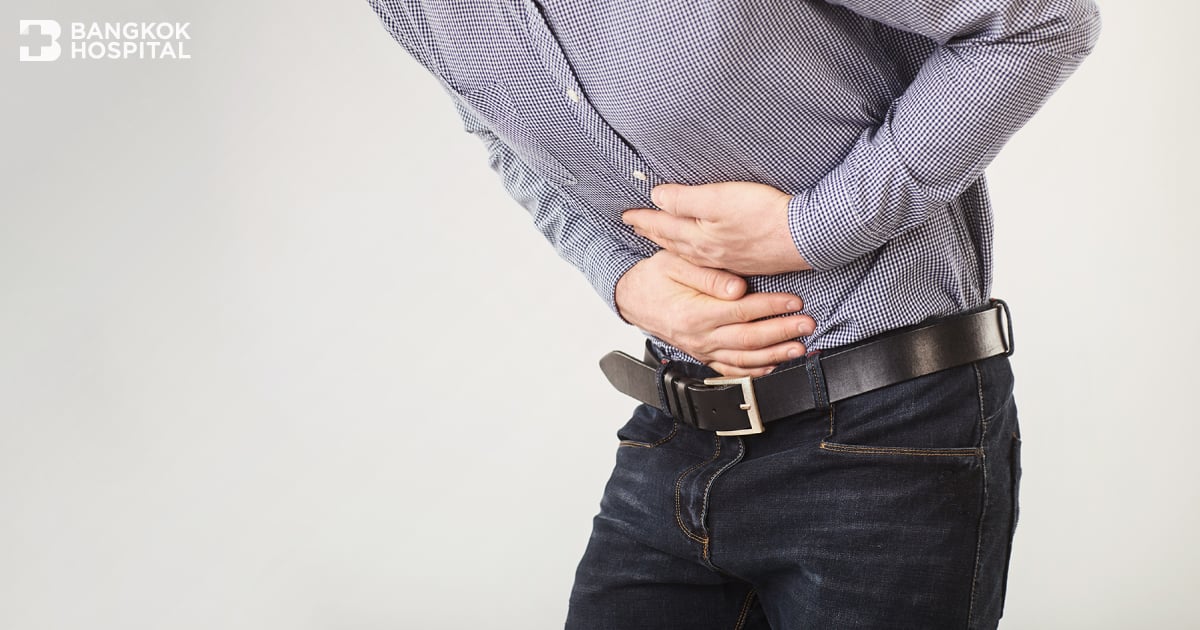Hernias occur when an organ especially small intestine protrudes through a weakened spot or tear in the abdominal wall. Hernias are commonly caused by a combination of muscle weakness and increased abdominal pressure.
Hernias cause a bulge or lump in the affected area such as groin (inguinal hernia), umbilicus (umbilical hernia) or surgical incision which is not properly closed (incisional hernia). If the protruding intestine is not pushed back in place, the contents of hernia might be trapped in the abdominal wall, then becoming strangulated which cuts off blood supply to surrounding tissue that is trapped. If it is left untreated, a strangulated hernia can lead to life-threatening conditions such as necrotizing enterocolitis (severe inflammation of intestine) and sepsis. Since hernias can happen to anyone at any age, knowing warning signs of hernias and being aware of them are essential. If suspected signs and symptoms are presented, early diagnosis and timely treatment must be provided as soon as possible.
Get to know hernias
Hernias occur when an organ especially small intestine protrudes through a weakened spot or tear in the abdominal wall. Hernias cause a bulge or lump in the affected area, depending on individuals such as groin (inguinal hernia), umbilicus (umbilical hernia), diaphragm (hiatal hernia) or surgical incision which is not properly closed (incisional hernia). In young men, the most affected area is groin while most of hernia cases in women are commonly found in the inner upper part of the thigh or groin (femoral hernias).
Types of hernias
There are different types of hernias classified by affected area and causes. Regardless of hernia types, surgery is considered main treatment option. The most common forms of hernia are:
- Groin or inguinal hernia: Inguinal hernia is caused by fatty tissue or a part of the intestine pokes into the groin at the top of the inner thigh. This is the most common type of hernia and it affects men more often than women. In many cases, the abdominal wall weakness leading to an inguinal hernia occurs at birth when the abdominal lining (peritoneum) does not close properly. Other inguinal hernias can develop later when muscles weaken or deteriorate due to trigger factors such as aging, coughing and strenuous physical activities. Occasionally, it causes pain and swelling around the testicles when the protruding intestine descends into the scrotum. Serious complications of inguinal hernias is the strangulated hernias, an emergency condition that blood supply to the intestines is cut off.
- Umbilical hernia: This hernia develops when a portion of the lining of the abdomen, part of the intestine or fluid from the abdomen comes through the muscle of the abdominal wall, presented as an abnormal bulge that can be seen or felt at the umbilicus (belly button). Umbilical hernias can develop after the baby is born and they normally close on their own by 2 years of age.
- Hiatal hernia: Part of the stomach or esophagus pushes up into the chest cavity through an opening in the diaphragm (the horizontal sheet of muscle that separates the chest from the abdomen). Symptoms are considerably similar to gastroesophageal reflux disease (GERD).
- Femoral hernia: Fatty tissue or part of the intestine protrudes into the groin at the top of the inner thigh. Femoral hernias mainly affect women.
- Obturator hernia: An obturator hernia is a rare type of hernia of the pelvic floor in which pelvic or abdominal content protrudes through the obturator foramen which is a large gap in the hip bone.
- Incisional hernia: An incisional hernia occurs at close proximity to a surgical incision through which intestine, organ or other tissue protrudes which is seen as a bulge at the surgical wound.
Risk factors
Risk factors of hernias might include:
- Advanced age
- Birth defects
- Lifting heavy weights
- Chronic cough
- Chronic respiratory diseases such as emphysema and chronic bronchitis
- Benign prostatic hyperplasia (BPH)
- Constipation or strain during bowel movement or urination
- The abnormal buildup of fluid in the abdomen (ascites)
- Overweight or obesity
- Heavy smoking
- Pregnancy that increases abdominal pressure
Signs and symptoms of hernias
Hernias are often asymptomatic. The most common symptoms are pain or discomfort (usually at lower abdomen), weakness or heaviness in the abdomen, burning or aching sensation at the bulge. Hernias can be particularly felt during standing up, bending down or coughing. Hernias typically flatten or disappear when they are pushed gently back into place or when patients lie down. If the protruding intestine is not pushed back in place, the contents of hernia might be trapped in the abdominal wall, then becoming strangulated which cuts off blood supply to surrounding tissue that is trapped. If signs and symptoms of hernias are indicated, immediate medical attention must be sought in order to receive accurate diagnosis. Other conditions that might have similar symptoms include abdominal mass or tumor, lymphadenitis (infection of lymph nodes), hydrocele (swelling in the scrotum that occurs when fluid collects in the thin sheath surrounding a testicle), testicular torsion (the spermatic cord, which provides blood flow to the testicle, rotates and becomes twisted) and lymphogranuloma venereum, a sexually transmitted disease (STD) caused by Chlamydia trachomatis.
If the diagnosis is not readily apparent in some cases, radiological imaging tests such as an abdominal ultrasound, CT scan or MRI might be needed. Treatment plans are entirely depending on types and severity of hernias as well as patient’s overall health status. If hernia is left untreated, the size of protruding intestine might get bigger and become strangulated leading to the reduction of blood flow to surrounding tissue. Urgent treatment must be provided in order to prevent related complications such as bowel obstruction and necrotizing enterocolitis (severe inflammation of intestines).
Treatment of hernias
Painful or enlarging hernias usually require surgical treatment to relieve discomfort and prevent other serious complications. There are two general types of hernia surgery:
- Open hernia repair
In this procedure, an incision (open cut) in the groin is made and the protruding tissue is pushed back into the abdomen. The surgeon then sews the weakened area that often reinforcing it with a synthetic mesh (hernioplasty). The opening is then closed with stitches, surgical glue or staples. Since it is typically done with local anesthesia, thus this surgical technique is suitable for patients with underlying diseases which are contraindicated to the use of general or spinal anesthesia. - Minimally Invasive Surgery: Laparoscopic repair
In this minimally invasive procedure, instead of making an open cut, the surgeon operates through 3 small incisions in the abdomen. A small tube attached with a tiny camera (laparoscope) is inserted into one incision. Guided by this camera, the surgeon then inserts tiny instruments through other incisions to repair the hernia by pushing protruding tissue back in place. To enhance the strength of muscles in the abdominal wall, during this surgery, “synthetic mesh” will be implanted to provide additional support to weakened areas. The majority of surgical mesh devices currently available for use are constructed from safe synthetic materials, sized 10 x 15 cm. Not only reducing the tenderness and pain after surgery, but mesh repair done by highly experienced surgeons also significantly helps minimizing the chance of hernia recurrence. This procedure requires general anesthesia and it takes approximately 45-60 minutes. Since the surgical incisions are only 5-10 mm. long, it subsequently results in minimized pain and shorter hospital stay with faster recovery time and a quick return to daily activities.
Incarcerated hernia
An incarcerated hernia occurs when herniated tissue becomes trapped in the weak point in the abdominal wall and cannot easily be moved back into place, As a result, it can obstruct the bowel, leading to intestinal obstruction. If this condition is left untreated longer than 6 hours, incarcerated hernia can cut off blood flow to part of the intestine, resulting in strangulated hernia. This strangulated tissue can rupture and release toxins and spread bacterial infection into the bloodstream, which could lead to fatal conditions such as sepsis. Incarcerated and strangulated hernias are medical emergencies which surgeries are urgently required. The goal of treatment primarily aims to push back protruding intestine or tissue into place while preventing recurrences. If the protruding part cannot be pushed back, incarcerated intestine must be surgically removed.
Laparoscopic totally extraperitoneal hernia repair of inguinal hernias
To achieve the best possible outcomes of inguinal hernia surgery, the expert of surgeons in laparoscopic technique plays a crucial role since the procedure involves blood vessels and a number of small nerves in the abdominal cavity. Due to the advancements in laparoscopic instrument with 4K Ultra High Definition, enables surgeons to clearly visualize the surgical field in the abdominal cavity including internal organs, blood vessels and nerves. As a consequence, it helps enhancing surgical accuracy, resulting in smaller incisions, less pain, less blood loss and reduced post-operative complications as well as a faster recovery time and a quicker return to normal activities. More importantly, to effectively prevent recurrences, risk factors that aggravate hernias must be strictly avoided. If warning signs and symptoms such as a bulge or lump with discomfort are presented, medical attention must be sought immediately. Timely and effective treatments help to prevent serious complications and minimize risks of recurrent hernias.








.jpeg)

